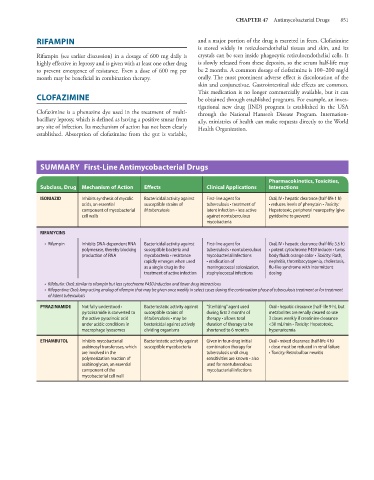Page 865 - Basic _ Clinical Pharmacology ( PDFDrive )
P. 865
CHAPTER 47 Antimycobacterial Drugs 851
RIFAMPIN and a major portion of the drug is excreted in feces. Clofazimine
is stored widely in reticuloendothelial tissues and skin, and its
Rifampin (see earlier discussion) in a dosage of 600 mg daily is crystals can be seen inside phagocytic reticuloendothelial cells. It
highly effective in leprosy and is given with at least one other drug is slowly released from these deposits, so the serum half-life may
to prevent emergence of resistance. Even a dose of 600 mg per be 2 months. A common dosage of clofazimine is 100–200 mg/d
month may be beneficial in combination therapy. orally. The most prominent adverse effect is discoloration of the
skin and conjunctivae. Gastrointestinal side effects are common.
This medication is no longer commercially available, but it can
CLOFAZIMINE be obtained through established programs. For example, an inves-
tigational new drug (IND) program is established in the USA
Clofazimine is a phenazine dye used in the treatment of multi- through the National Hansen’s Disease Program. Internation-
bacillary leprosy, which is defined as having a positive smear from ally, ministries of health can make requests directly to the World
any site of infection. Its mechanism of action has not been clearly Health Organization.
established. Absorption of clofazimine from the gut is variable,
SUMMARY First-Line Antimycobacterial Drugs
Pharmacokinetics, Toxicities,
Subclass, Drug Mechanism of Action Effects Clinical Applications Interactions
ISONIAZID Inhibits synthesis of mycolic Bactericidal activity against First-line agent for Oral, IV • hepatic clearance (half-life 1 h)
acids, an essential susceptible strains of tuberculosis • treatment of • reduces levels of phenytoin • Toxicity:
component of mycobacterial M tuberculosis latent infection • less active Hepatotoxic, peripheral neuropathy (give
cell walls against nontuberculous pyridoxine to prevent)
mycobacteria
RIFAMYCINS
• Rifampin Inhibits DNA-dependent RNA Bactericidal activity against First-line agent for Oral, IV • hepatic clearance (half-life 3.5 h)
polymerase, thereby blocking susceptible bacteria and tuberculosis • nontuberculous • potent cytochrome P450 inducer • turns
production of RNA mycobacteria • resistance mycobacterial infections body fluids orange color • Toxicity: Rash,
rapidly emerges when used • eradication of nephritis, thrombocytopenia, cholestasis,
as a single drug in the meningococcal colonization, flu-like syndrome with intermittent
treatment of active infection staphylococcal infections dosing
• Rifabutin: Oral; similar to rifampin but less cytochrome P450 induction and fewer drug interactions
• Rifapentine: Oral; long-acting analog of rifampin that may be given once weekly in select cases during the continuation phase of tuberculosis treatment or for treatment
of latent tuberculosis
PYRAZINAMIDE Not fully understood • Bacteriostatic activity against “Sterilizing” agent used Oral • hepatic clearance (half-life 9 h), but
pyrazinamide is converted to susceptible strains of during first 2 months of metabolites are renally cleared so use
the active pyrazinoic acid M tuberculosis • may be therapy • allows total 3 doses weekly if creatinine clearance
under acidic conditions in bactericidal against actively duration of therapy to be <30 mL/min • Toxicity: Hepatotoxic,
macrophage lysosomes dividing organisms shortened to 6 months hyperuricemia
ETHAMBUTOL Inhibits mycobacterial Bacteriostatic activity against Given in four-drug initial Oral • mixed clearance (half-life 4 h)
arabinosyl transferases, which susceptible mycobacteria combination therapy for • dose must be reduced in renal failure
are involved in the tuberculosis until drug • Toxicity: Retrobulbar neuritis
polymerization reaction of sensitivities are known • also
arabinoglycan, an essential used for nontuberculous
component of the mycobacterial infections
mycobacterial cell wall

